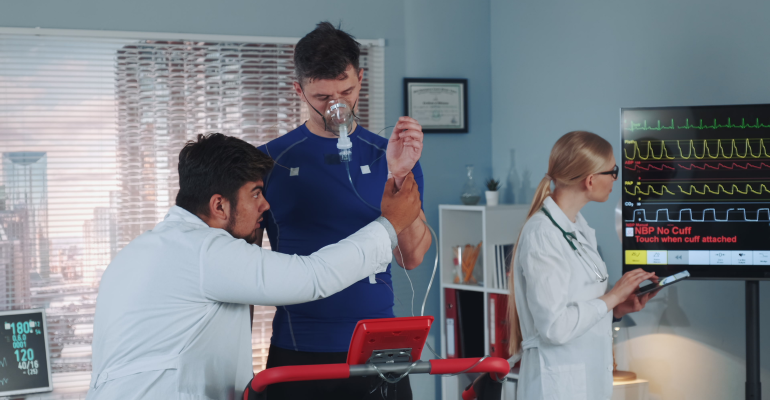In efforts to contain the spread of COVID-19, various methods such as social distancing and mandatory wearing of masks have been implemented. However, caution must be employed to ensure complete control of the transmission of droplets and aerosols which carry the virus. Respiratory aerosols are produced while breathing and may carry respiratory viruses and spread them onto surfaces and people. Researchers at Mayo Clinic discovered during an exercise stress test for heart patients that a high level of exertion results in an increased concentration of aerosol in the surrounding room. Another finding prompted a solution of using a high-efficiency particulate air filter (HEPA) to effectively screen out aerosols and decrease the time required between patients to clear the air.
Thomas Allison, Director of Cardiopulmonary Exercise Testing at Mayo Clinic in Rochester, Minnesota, and senior author of both studies which are published in the journal CHEST spoke about how during the early onset of the pandemic, the necessity of adopting new measures was paramount in protecting patients and staff from the virus while continuing to provide quality cardiovascular care. “We quickly realised that there might be a risk of conducting exercise tests on patients with asymptomatic COVID-19. Cardiovascular Medicine leadership at Mayo asked me to first review existing published material to see if aerosol generation by exercise was documented and, if so, how the lab might mitigate these aerosols. My review showed that the subject of aerosols and exercise was not previously addressed, therefore, we put a research team together to find answers through scientific testing and data,” he says.
The genesis of the study
In the first study, a dedicated aerosol laboratory was set up in a plastic tent with controlled airflow to identify the aerosols generated during various intensities of exercise. Equipment that measured oxygen consumption, ventilation, and heart rate was worn by eight exercise volunteers and two types of laser beam particle counters were used to measure aerosol concentration at the front, back and sides of a person riding an exercise bike.
With intervals of five minutes, followed by four rounds of three-minute exercises staged with monitoring and coaching at 25, 50, 75, and 100 per cent of the age-predicted heart rate of the volunteer, there was a surge in aerosol concentrations throughout, especially during exercise at or above 50 per cent of resting heart rate.
"In a real sense, I think we have proven dramatically what many suspected ― that is why gyms were shut down and most exercise testing laboratories closed their practices. Exercise testing was not listed as an aerosol-generating procedure prior to our studies because no one had specifically studied it before,” Dr Allison says. “Exercise generates millions of respiratory aerosols during a test, many of size reported having virus-carrying potential. The higher the exercise intensity, the more aerosols are produced.”
HEPA’s effectiveness
Dr Allison's follow-up study looked at how to reduce the number of aerosols produced during exercise testing by filtering them out of the air directly after exiting the subject’s oral cavity. The controlled airflow exercise tent, particle counter, and stationary cycle were repeated with the inclusion of a portable HEPA filter with a flume hood. The 20-minute exercise test was completed by six volunteers, without the mitigation, followed by the portable HEPA filter running.
“We performed experimental studies in a tightly controlled environment where we could accurately measure aerosol production and mitigation. The research allowed us to quickly return to full capacity in the exercise labs. Stress testing is a necessary (Class I) indication for diagnosis and management of many cardiovascular conditions, so it was necessary to bring this service back online while eliminating risk for patients and staff.”
A separate experiment at the clinical exercise testing laboratories tested aerosol clearance time by using artificially generated aerosols to assess the duration for 99.9 per cent of the aerosols to be cleared. The test was conducted initially with only existing heating, ventilation, air conditioning, and then with the portable HEPA filter operating.
"Studying clearance time informed us of how soon we could safely bring a new patient into the laboratory after finishing the test on the previous patient. HEPA filters cut this time by 50 per cent, allowing the higher volume of testing necessary to meet the clinical demands of our Cardiovascular Medicine practice," Dr Allison says.
The researchers translated U.S. Centers for Disease Control and Prevention guidelines for aerosol mitigation with enhanced airflow through HEPA filters and demonstrated that it worked well for exercise testing: the HEPA filter removed 96 per cent (plus or minus 2 per cent) of all aerosols of all sizes generated during heavy exercise.
In the hospital setting, isolation rooms employ air recirculators with HEPA filters. “The U.S. Center for Disease Control and Prevention recommended HEPA filters to help control exposure to SARS-COV-1, so we thought that this might be a good strategy for mitigating SARS-CoV-2. We figured out the easiest way to use HEPA filters in the exercise lab. Our research then confirmed the benefit. As a result, we have been able to return to our practice of performing up to 100 stress tests per day without any recorded transmission of COVID in our exercise testing laboratories," he concludes.
A further look on precautions exercise facilities should consider:
Dr Allison comments on how controlling the risk of spread of COVID-19 in gyms where multiple people are exercising is difficult, but shares strategies on how to overcome the challenge:
- Check temperatures of people as they enter the gym
- Vaccination required to use the facility
- Enhance airflow as much as possible
- Maintain as much distance as possible between stations, such as a treadmill, where vigorous exercise is being performed
- Limit the number of people who can be using the facility at any one time, perhaps through an appointment system
- Clean surfaces regularly.

